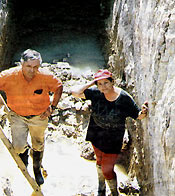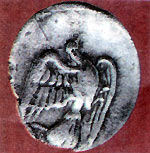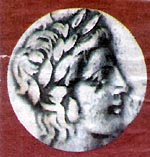
|
A city lost in the night In 373 BC a tremendous earthquake and tidal wave wiped the city |
The cataclysm is rated second-worst known ancient Greece, exceeded in violence only by the volcanic explosion of Thera (Santorini) more than a millennium earlier. Palaeoseismologists reckon the Helike quake reached seven degrees on the Richter scale. They point out the fault line conspicuously slashing the rocky cliff-face rising from the delta of the selinous and Kerynites rivers, and say it is the most active in the Euro-Mediterranean region. Two buildings collapsed and 26 people died in the most recent big quake of 6.2 degrees, its epicentre at nearby Egio, in June 1995. Other major tremblors were recorded in 1748, 1861. And 1888. Helike was appropriately renowned as long as 4,000 years ago for its sanctuary of Heliconian Poseidon, god of earthquakes, as well as the sea. According to Homer, bull sacrifices were offered there to the Earthshaker. A Trojan hero, stabbed in the back with a spear by Achilles, “blew his life away bellowing, as when a bull bellows as he is dragged for Poseidon, lord of Helike (Iliad, book 20, Richmond Lattimore translation).” Sybaris, the famous daughter In historical times after the first Olympic in 776 BC, Helike was one of the many cities-states from which Greeks sailed across the Ionian Sea to found a colony in southern Italy. Named Sybaris, dating from about 730 BC, Helike’s daughter city evolved a lifestyle proverbial to this day for comfort and luxury.
Sybaris was razed by jealous rival Kroton in 510 BC, and in modern times its location identified again only in 1960 by Italian geologist Vincenzo Cotecchia, who has shown interest in the search for the vanished mother-city. Searching the texts The philosopher-geographer Strabo recorded that Helike “was wiped out by a wave of the sea (Geography”, book 8).” Recounting the calamity at the beginning of the Christian era, he wrote: “The sea was raised by an earthquake and it submerged Helike, and also the Temple of Heliconian Poseidon.” The event occurred “two years before the Battle of Leuctra,” said Strabo. This was fought in 371 BC, when Thebans defeated Spartans, ending 30 years of Spartan rule of Greece after the victory over Athens in the Peloponnesian War. Evidently intrigued by Helike’s fate, Strabo mentions the third-century BC Cyrene-born polymath Eratosthenes, who figured out the earth’s circumference with amazing accuracy when serving as head of the Alexandrian Library and had recalled: “Ferryman say that there was a bronze Poseidon in the strait, standing erect, holding a hippo-campus (fishing spear) in his hand, which was perilous for those who fished with nets.” Other useful intelligent comes to us from the philosopher Heracleides of Pontus, on the Black Sea, living at the time of the quake, a pupil of Aristotle’s who recorded that it happened at night, and although the city
With the aid of lots of modern technology, the quest for Helike has been vigorously taken up since 1988 in a project inspired by Egio-born archaeologist Dora Katsonopolous. Sound evidence began to come to light for the first time in the summer of 2000 that the ruins probably lay buried on the coastal plains between the Selinous and Kerynites rivers, about a kilometre inland from the coast, but for many years indeed under water, a salt-water lagoon which gradually lost salinity and became a brackish lake. A ghost city emerges By the end of last summer, the discovery was clinched. A plethora of finds had been amassed ranging from buildings ruins to great quantities of pottery and several coins from the early 4th century BC, up to the time of the quake in 373 BC. Buoyed by high hopes of further discoveries, Katsonopolou and multidisciplinary international team – Greeks, Americans, British, French, Italian Czech and others – carried out another season of excavation this summer, with finds remaining to be announced. Describing the successful location of the site of the lost Classical city in the middle of the delta plain, Katsonopolou explains that many large trenches have been dug among the olive groves, citrus orchards and vineyards. Major architectural remains are about three metres deep, some buried in thick lagoonal deposits. Rich finds have been turned up – Classical fineware, coarseware pottery fragments of cooking pots, storage and transport jars, tableware as well as coins and other objects. Black-glazed pottery is from the same time as the coins, she adds, and some shards are decorated with anthemia – floral designs – copying Athenian prototypes of the time. Many fallen wall stones and roof tiles scattered round are taken as proof of destruction by earthquake. Other signs point to backwash from tsunami (seismic waves.) The stratigraphy shows the ruins were covered with water after seismic subsidence, at first seawater, later freshwater. Analysis of greenish clay sediment has revealed the presence of fossilized marine, as well as freshwater microfauna. In test done blind at Miami University, marine biologist Carlos Alvarez Zarakian identified an amoeba-like marine protozoan and an ostracod, a small freshwater crustacean, regarded as a useful indicator of environmental change. Beyond expectations had been unearthing of extensive Early Bronze Age remains of 2500-2300 BC in four trenches near Rizomylos, about four metres deep. Buildings there in their time, too, were destroyed by earthquake and drowned in seawater. Dating is thanks to pottery finds, much preserved intact, including two-handled bowls, pedestal-footed cups, tankards, cooking pots, narrowed-necked vessels and pithoi. Prize find, perhaps indicating the settlement’s prestige, is of a depas amphikypellon (royal drinking cup), a term given currency by Heinrich Schliemann for a vessel found at Troy, resembling one described in the Iliad as Nestor’s cup. Katsonopolou judges the depas, possibly an import from Troy, as “of outstanding significance”, and says though the shape is well known from round Troy and the northeast Aegean, and from several found in mainland Greece, this is the first known from the Peloponnese. A couple of other luxury finds, one gold, one silver ornament, also suggest a certain status for the place. Not to be criticized as treasure hunters, politically correct archaeologists of today try not to put too much emphasis on individual objects they discover, attempting to improve understanding of an era over time instead. With finds spanning the Greek past from Early Bronze Age to mediaeval Byzantine days, the Helike project team is satisfied its work is doing this for Achaean region. |
|



